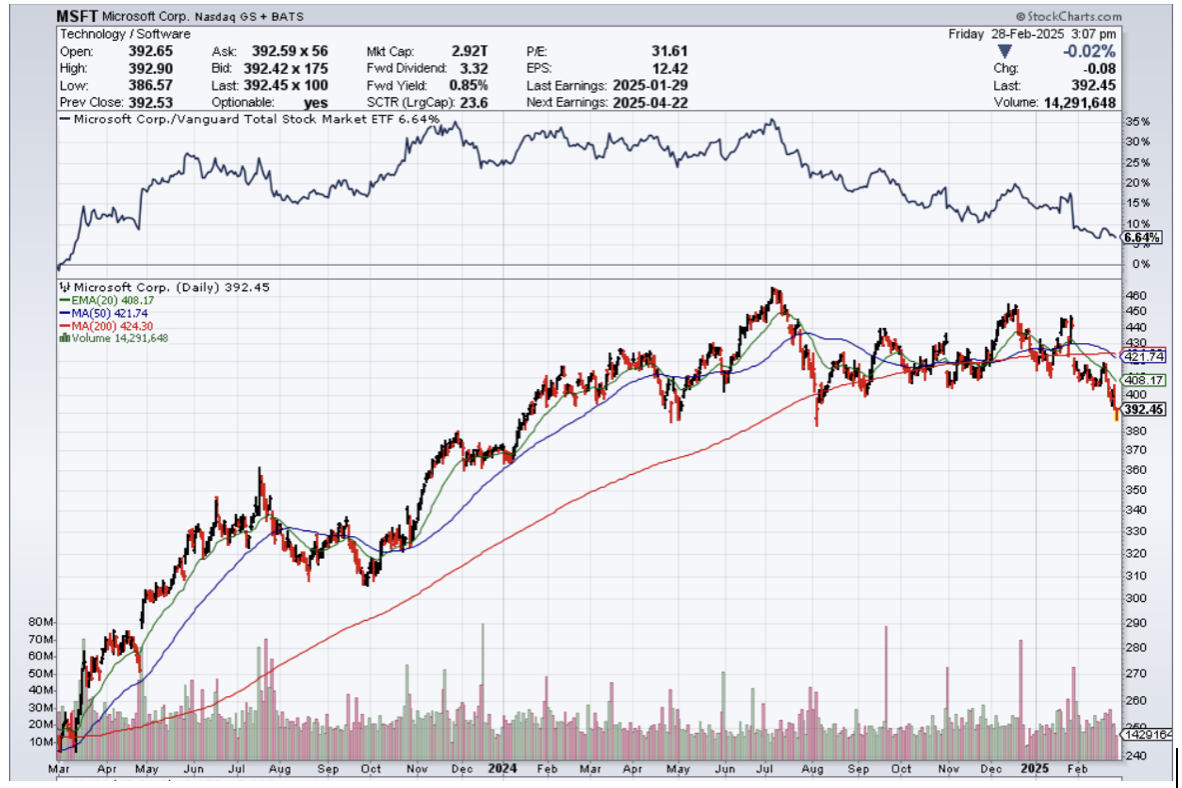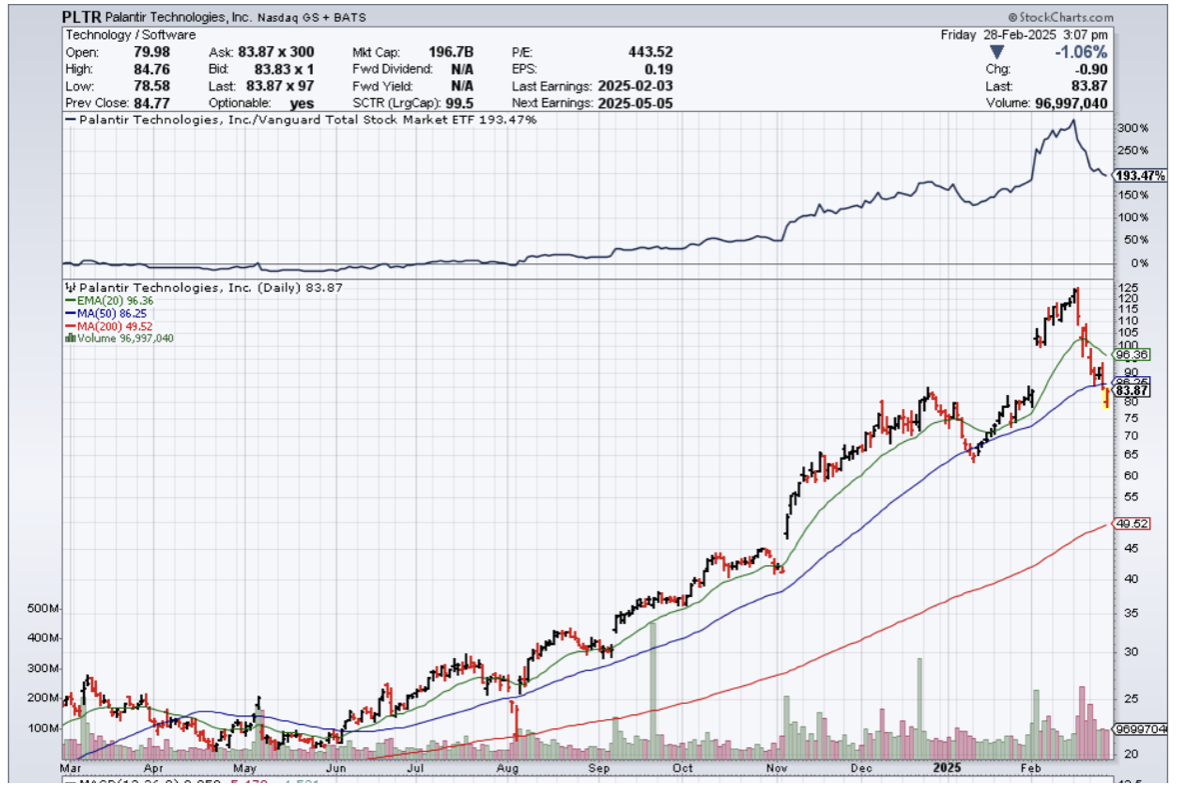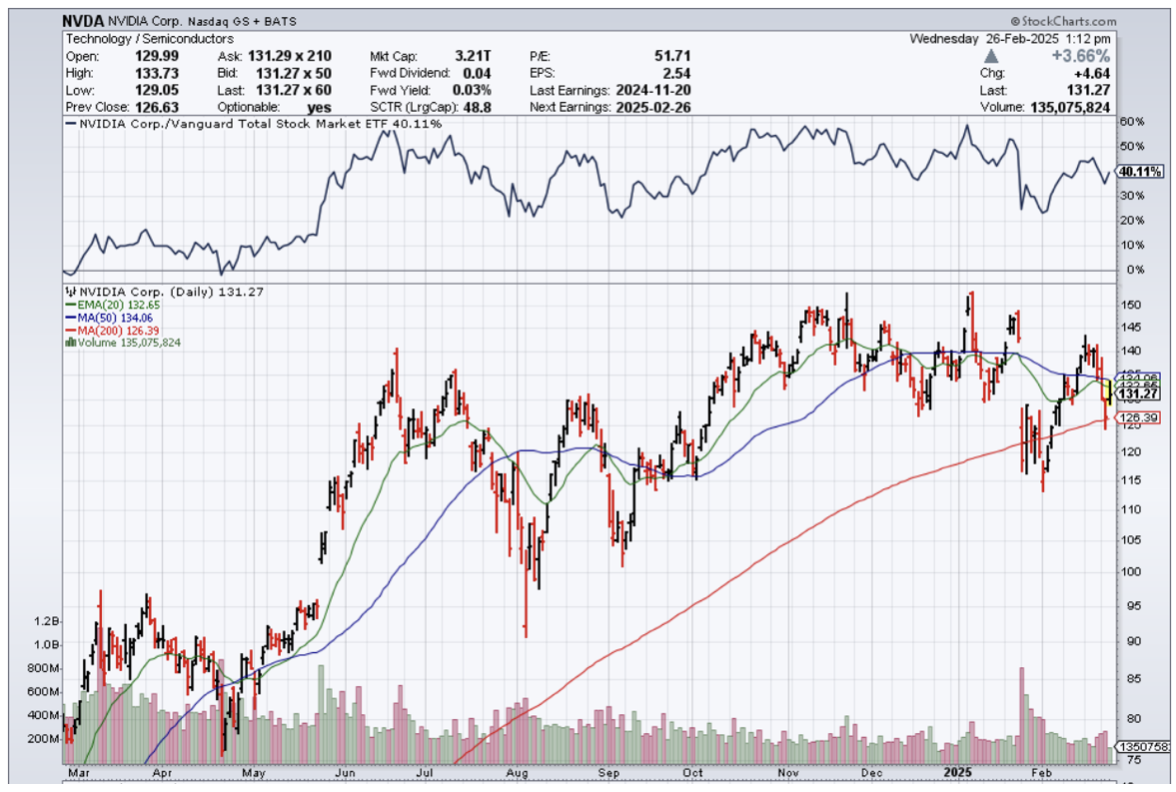“Man has the power to act as his own destroyer - and that is the way he has acted through most of his history.” – Said Elon Musk

“Man has the power to act as his own destroyer - and that is the way he has acted through most of his history.” – Said Elon Musk

Mad Hedge Technology Letter
February 28, 2025
Fiat Lux
Featured Trade:
(BITCOIN PRICE A SCARE)
(MSFT), (META), ($BTCUSD)

It’s fascinating that Bitcoin was supposed to be the new currency of the Trump administration, and under those conditions, one might believe the price of Bitcoin will double and triple pretty soon.
The results have been dire since the new President took over, with the price of Bitcoin cratering to $77,000 per coin from $107,000.
These devastating results have caught traders off guard, and many have lost their shirts in the quiet storm.
I don’t really care about Bitcoin personally, and I’m usually not in the business of recommending the product, but I do care what it signals about liquidity and the risk on/off sentiment.
The tariffs are starting to scare investors, and we see it in the price of Bitcoin.
Liquidity being pulled can create a cascading effect where nobody knows where the floor is.
Bitcoin could fall a lot further, considering many could just not be bothered to fight through the tariffs and can’t stomach it.
Nobody ever went bankrupt from taking a profit, right?
With all-time highs in many asset classes, it is almost as if Trump thinks he is playing with house money to push through aggressive strategies that put enormous trade pressure on other countries.
It’s a political calculus that fosters uncertainty, and many know that markets hate uncertainty, especially tech stocks.
On the heels of a good Nvidia earnings report, we have received a sell on the news price action, and that is very negative to the overall tech sector.
Year to date, we stand 3.5% in the red, but looking to March expiration, I believe this is a short 3-week buying opportunity until the next bevy of geopolitical chaos.
I recommend keeping your portfolio small for the time being and let the trade rhetoric pass through until you go big.
I did execute 2 more bullish positions in Palantir and Microsoft today.
A rout in Bitcoin deepened forced money to the sideline in the face of the most popular Trump trades.
Alt coins also did poorly too with Ether, Polkadot, and XRP all dropping more than 7% in one day.
Remember in 2022 during the crypto winter, when prices plummeted amid rising interest rates and industry woes.
Trump said Thursday that 25% tariffs on Canada and Mexico would come into force from March 4, undermining hopes he might reverse course after a previous delay. He also said Chinese imports would face a further 10% levy, prompting officials in Beijing to promise “all necessary measures” in response.
The selloff underscores a swift change of fortunes for what was previously one of the most popular Trump trades in global markets: buying Bitcoin on the expectation that the president’s crypto-friendly approach would lead to a broad rally.
Traders are still waiting for Trump to come up with concrete steps for the sector, including a Bitcoin stockpile.
Trump has already made a few changes that have pleased crypto bulls, including putting crypto advocates in key positions. The Securities and Exchange Commission, which embarked on a year-long crackdown under former Chair Gary Gensler, has also closed investigations into several crypto outfits in recent weeks.
Readers shouldn’t get too rattled by the geopolitics.
More often than not, the bluster serves as a good entry point into tech stocks.
I do believe 2025 will be the year of volatility, and buying on these big dips is a big part of our benefit to it.


“We are the first species capable of self-annihilation.” – Said CEO of Tesla Elon Musk

Mad Hedge Technology Letter
February 26, 2025
Fiat Lux
Featured Trade:
(NVIDIA EARNINGS TO SWAY THE NASDAQ)
(NVDA), (META), (BTCUSD)

It’s been a steep drop for tech stocks the last few days and there is a lot to piece through here.
It was due at some point.
Look, we are at Himalayan highs in the Nasdaq and that doesn’t mean it will be smooth sailing from here.
To find that incremental dollar to push up tech stocks is not as easy as it once was.
We aren’t in the golden years of technology anymore.
The big question is why someone should input that extra dollar when there is a flattening of momentum in the entire tech establishment.
A.I. is the big two-letter acronym that everyone is focused on so it is not a surprise that profits are being taken leading up to Nvidia’s earnings.
Nvidia isn’t as ironclad as it used to be and that worries me.
Nvidia is carrying the market on its back like it has been doing for the past year and market breadth has remarkably narrowed.
If there was no Nvidia, we would be looking at a demonstrably lower stock market than this expensive stock market we are trading right now.
Remember that I urged readers to pile into tech stocks after that mid-January Deepseek selloff and that was the perfect elixir to profits.
Now, where do we find that indicator or signal to go green?
It’s a tough one and we must be patient.
All I have left in the portfolio is a bull call spread in Meta that has been taken out to the woodshed and beaten like the proverbial red-headed stepchild.
Then we look at other signs of liquidity and alternative barometers and Bitcoin has to scare you.
The quicksand drop to $85,000 per coin questions whether the bull market in tech stocks is still alive or kicking.
At the very minimum, the kicking is getting weaker and weaker each following earnings season.
But investors can hold on to hope for a few more hours. After the bell today, the world turns to fourth-quarter earnings for the linchpin of AI euphoria, Nvidia (NVDA).
This two-plus-year bull market has weathered several multi-month periods when Nvidia's stock price sputtered. But the company's stock hasn't contributed to the bull market since last June, as its share price has effectively gone nowhere in that time.
Over the last 10 years (40 reports), buying Nvidia stock just before the earnings announcement has yielded a median return of 3% to 4% on the one-day, one-week, and one-month time frames. Holding for three months has yielded nearly 18%.
The disparity highlights the volatile earnings reactions that might net bullish results but can also cause significant discomfort in the near term.
But for the entire Nvidia obsession, investors are right to question how much AI is still a picks-and-shovels or even an energy trade (as it morphed into in 2024).
If I had to nail down a date, investors expect the 2nd half of 2025 to calculate what exactly future cash flow will look like and if the infrastructure investment in AI is really worth the hassle.
A great deal of capital was asked to front AI and we are creeping towards that day where AI will need to sink or swim.
As it stands, the AI overlords like OpenAI helmed by Sam Altman, still puts on a happy face like nothing will fail to surpass expectation. It is easier to put on a good face when someone is worth billions upon billions.
In the short, we are preparing for a buying opportunity in the best and brightest.

“In order to have your voice be heard in Washington, you have to make some little contribution.” – Said Elon Musk

Mad Hedge Technology Letter
February 24, 2025
Fiat Lux
Featured Trade:
(AI IS IN QUESTION)
(ELON MUSK AND OPEN AI)

Elon Musk wants to buy OpenAI and that partly has to do with the vendetta he has against OpenAI CEO Sam Altman.
This fiery feud isn’t going away anytime soon.
My bet is that it will burst into the open and OpenAI is actively attempting to put the governance in place to block Musk from seizing the company.
The issue Musk has with OpenAI is that it was founded as a non-profit from capital Musk gave.
It was responsible for doing what is right for humanity, but Altman’s attitude to the industry shows the inverse of that.
It appears to the outsiders that Altman is hellbent on driving the price of AI up for the consumer and delivering profits to big tech that have invested into his “non-profit.”
Musk’s recent attempt at an unsolicited takeover was rejected by CEO Sam Altman and OpenAI's nonprofit board.
Now the creator of ChatGPT reportedly wants to make sure that there are indirect poison pills associated with any outsider takeovers.
All of that will take some maneuvering by OpenAI’s board members and Altman, all of whom are defendants in a lawsuit from Musk that seeks to block OpenAI from converting to a for-profit business.
Right now, investors like Microsoft are not equity holders in OpenAI but instead hold limited profit interests in OpenAI's for-profit subsidiary. Once OpenAI is profitable, Microsoft is entitled to 75% of profits until it recoups its $13 billion principal investment. The other 25% of profits go to employees and early investors, up to specified profit caps.
Once Microsoft’s principal is repaid, it is entitled to 50% of its profits until it reaches a profit cap of $92 billion.
OpenAI said it wants to convert its nonprofit parent to a Delaware public benefit corporation (PBC) that would issue ordinary shares of stock.
Charitable organizations aren’t typically targets for hostile takeovers, especially not the type that Musk had in mind — an unsolicited $97.4 billion bid for OpenAI’s estimated $157 billion in intellectual property and other assets.
Musk's lawsuit seeking to prevent OpenAI's conversion to a for-profit enterprise centers around Musk's initial $45 million donation to fund the startup, which he claims was contingent on OpenAI remaining a nonprofit organization.
If Musk ever acquires OpenAI, I believe he will put on his DOGE hat and cut the costs of doing AI.
The genie is now out of the bottle and the Chinese have proved that AI doesn’t need the bloat.
AI can run on cheaper and older chips while not needing the same amount of data centers.
My belief is that Musk wants to democratize AI and make it cheap for everyone and that would be bad for tech shares specifically Nvidia and Microsoft.
Big tech has the incentive to make the price of AI high just like the supermarkets have an incentive to place higher prices in the supermarkets.
Don’t believe in this mumbo jumbo of supermarkets operating on thin margins when they do produce a lot of their own house brands.
Musk wants to take a samurai sword to AI and make it applicable to the average American.
He doesn’t want to see a situation in which AI is used by executives at corporations to fire everyone, and the readers should know that we are barreling right down the path of replacing workers with robots right now.
If Musk ever gets into the position of neutralizing OpenAI, sell your tech stocks right away, because there will be less peaks and more valleys in tech share prices after that.

Mad Hedge Technology Letter
February 21, 2025
Fiat Lux
Featured Trade:
(THE AFFORDABLE IPHONE FROM APPLE)
(AAPL)

Legal Disclaimer
There is a very high degree of risk involved in trading. Past results are not indicative of future returns. MadHedgeFundTrader.com and all individuals affiliated with this site assume no responsibilities for your trading and investment results. The indicators, strategies, columns, articles and all other features are for educational purposes only and should not be construed as investment advice. Information for futures trading observations are obtained from sources believed to be reliable, but we do not warrant its completeness or accuracy, or warrant any results from the use of the information. Your use of the trading observations is entirely at your own risk and it is your sole responsibility to evaluate the accuracy, completeness and usefulness of the information. You must assess the risk of any trade with your broker and make your own independent decisions regarding any securities mentioned herein. Affiliates of MadHedgeFundTrader.com may have a position or effect transactions in the securities described herein (or options thereon) and/or otherwise employ trading strategies that may be consistent or inconsistent with the provided strategies.
This site uses cookies. By continuing to browse the site, you are agreeing to our use of cookies.
OKLearn moreWe may request cookies to be set on your device. We use cookies to let us know when you visit our websites, how you interact with us, to enrich your user experience, and to customize your relationship with our website.
Click on the different category headings to find out more. You can also change some of your preferences. Note that blocking some types of cookies may impact your experience on our websites and the services we are able to offer.
These cookies are strictly necessary to provide you with services available through our website and to use some of its features.
Because these cookies are strictly necessary to deliver the website, refuseing them will have impact how our site functions. You always can block or delete cookies by changing your browser settings and force blocking all cookies on this website. But this will always prompt you to accept/refuse cookies when revisiting our site.
We fully respect if you want to refuse cookies but to avoid asking you again and again kindly allow us to store a cookie for that. You are free to opt out any time or opt in for other cookies to get a better experience. If you refuse cookies we will remove all set cookies in our domain.
We provide you with a list of stored cookies on your computer in our domain so you can check what we stored. Due to security reasons we are not able to show or modify cookies from other domains. You can check these in your browser security settings.
These cookies collect information that is used either in aggregate form to help us understand how our website is being used or how effective our marketing campaigns are, or to help us customize our website and application for you in order to enhance your experience.
If you do not want that we track your visist to our site you can disable tracking in your browser here:
We also use different external services like Google Webfonts, Google Maps, and external Video providers. Since these providers may collect personal data like your IP address we allow you to block them here. Please be aware that this might heavily reduce the functionality and appearance of our site. Changes will take effect once you reload the page.
Google Webfont Settings:
Google Map Settings:
Vimeo and Youtube video embeds:
